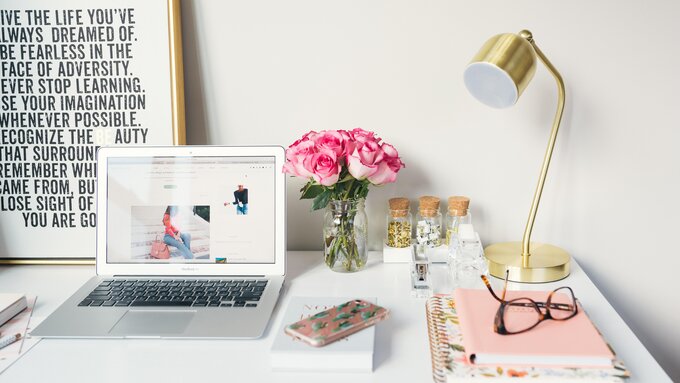As home working moves from a crisis response to longer-term change for many, maximising our environments for successful work-life balance is more important than ever. How we use our space — physically, psychologically and virtually — hugely impacts on our mental wellbeing as well as our work productivity. And even small changes can improve the experience. We look at some key ways to make your space work better for you.
Physical space
‘The impact of COVID-19 in terms of what we expect from our homes has been profound. We have all had to rethink our homes, and quickly address a total change in how we live and work,’ says interior designer, Benji Lewis, founder of Zoom That Room — a video call design consultancy service launched during lockdown. For Lewis, homeworking provides a chance to rethink: ‘You can now tailor your space to exactly how you would like it to be and I think that’s a remarkable opportunity.’
Lewis recommends you plan your home work station, as you would an entire room. ‘Ask yourself questions about how the room you are working in makes you feel. Is it warm enough? Have you got everything to hand? Are your office supplies organised as you want them? Do you have — or need — a view when you look up (and is that a pile of ironing at the moment?).’
The message to convey to yourself and to others with your working space is, ‘I know what I am doing’, and that means feeling and looking comfortable. If you’re balancing your computer on the side of your sofa or on a messy pile of papers, you’re always going to feel on the back foot. A good workstation also needs to be well-lit — with lighting coming from the side of the hand you write with. If possible, though, Lewis recommends using two desk lights to illuminate your desk properly from both sides, with 60-watt LED bulbs for effective but gentle ambient lighting as well as investing in a decent desk chair. A recent survey by the Institute of Employment Studies has noted a ‘significant increase in musculoskeletal complaints’ as a result of lockdown home working, caused by people tapping away in ergonomically unsound positions.
Ultimately, you will work better and be happier if your space reflects a sense of inner calm and purpose, notes Lewis. ‘A successful interior is about a feeling you get when you go into a room that says you enjoy being there.’
KEY TAKEAWAYS
- Embrace homeworking as a valuable opportunity to create an environment in which to work that inspires you — from the shape and size of your desk to the colours around you, organisation and your view. Not only will shaping it to suit have a positive impact on mood but it will most likely increase productivity too.
- Good lighting is key — the optimum being two sidelights that will illuminate your desk properly, and create ambience, especially in the winter months.
- Invest in a good chair and your back will thank you: sitting on a kitchen chair is not adequate for homeworking and can cause postural problems long-term.
Psychological space
Separating life and work when working at home is one of the biggest challenges. External boundaries such as a commute or lunch hour provide natural break points, and without these it is all too easy for boundaries to become blurred. In addition, research has found that stress and financial anxiety are now driving many workers to work longer hours, without taking enough time to recharge — the Mental Health Foundation reports that workers are putting in an extra 28 hours of work per month on average.
‘We all sprang into crisis mode at the start of the pandemic,’ says Emma Mamo, head of workplace wellbeing at Mind. ‘Now, it’s sinking in that this is it for the foreseeable future. There’s a paradox, because working from home gives you more flexibility, but it creates a greater risk of work bleeding into your personal life.’
However, mindfully using what space you have can help to create the structures in your day that physical movement alone would usually dictate. Researchers Olson-Buchanan and Boswell noted in The Journal of Vocational Behavior that when employees set clear boundaries between their work life and home life, they’re less likely to experience conflict between the two fronts. This means employing a level of ‘psychological detachment’(1) to replenish energy by switching off from work completely during time off. Within this, one of the best things you can do is to designate an area in your home where you do nothing but work — whether that is a home office or just the end of your kitchen table — to help you detach and signal to both your conscious and unconscious minds a delineation of activity.
Psychologically, you have to be able to ‘go into your working space’ wherever that is, so you can say to yourself, ‘I am here, clear and able to focus and I can get on with my work,’ says Lewis, who also notes that the challenges of home working have meant finding ways to integrate efficient work stations within spaces where we might usually relax and entertain. ‘The delineation between space for work and space for downtime has become key, especially when the only place for downtime has been within the home.’
As such, leaving your laptop in your workspace at night, rather than taking it onto the sofa or into the bedroom is key, as is creating psychological space by going through a morning routine — whether that is exercise, a proper breakfast, meditation, or all three — before opening the lid again in the morning.
Taking breaks as you would in a regular office is crucial too, and again you can use your space to help you — set timers to remind you to move or use apps such as Clockify, which tracks how long you’ve been on your computer then prompts you to leave the room, working space or your home to help reemphasis the difference between the ‘work state’ and the ‘rest state’ and allow you to recharge psychologically. Connecting physically — when Covid-19 restrictions allow — out of your house for coffee or lunch with others working from home, can also help allay any feelings of isolation.
KEY TAKEAWAYS
- Set timers to ensure you get up from your desk, move about and take regular breaks out of the space you are working in.
- Have one place designated for work in your home — and don’t be tempted to use it for any other purpose — to help you identify clear boundaries between your work time and your off time.
- Leave your laptop in its place — resist the urge to take it into the bedroom or onto the sofa and don’t let opening it back up be the first thing you do in the morning.
VIRTUAL SPACE
Boon and bane of home working, video conferencing is now key to keeping us connected with some sense of face-to-face communication while it’s impossible in real life. Much has been written of the need to curate our space when online to avoid embarrassing faux pas, but the next phase of this medium looks more to how we can use it to project a sense of professionalism and calm, and optimise our visual message.
‘As video calling has become the norm, it’s really important to ensure that the message you convey via your online interaction is slick and professional,’ says Lewis. ‘Everyone knows that you’re likely sat at the kitchen table, but this doesn’t mean that your backdrop should let you down. People pick up on visual messages and if you convey the message that you’re in control, video call participants will respond positively to that.’
Your video conferencing frame can be at your desk or designate a particular space in your home for this function that looks good on camera. Again, though, the key is to ensure this space is kept clean, organised and ready for action.
Lighting, colour and what else is in the frame will all have an impact on your presentation. ‘Too many people end up looking stark against a bright white background with a picture coming out of the side of their head. You have an opportunity to showcase yourself here in a different light though and it’s worth rising to the challenge.’
Look to see where the natural light is coming in and try to have it facing you, behind your computer screen, for the most flattering hue. Nice clean lines behind you indicate order and control, while clutter or chaos or a plethora of family photos on the wall can often provide so much visual information that people can find it hard to concentrate on you and what you are saying. A blank wall with a simple offset picture can be effective as a basic background – or contemplate a little redecoration. Brick, whether wallpaper or real, is a flattering backdrop, or gentle colours such as blues or dull pink. But think about your colouring, warns Lewis: ‘If you’re dark-haired and you have a dark background, for example, it will look as if you have no hair’. The questions to ask are; who am I and how do I showcase myself to my best in this small space? And remember: just because something looks nice in real life it doesn’t mean you will look good against it. Test your video conferencing frame before using it on a video call with photos or short videos, and don’t forget to move the camera around, twisting and tilting it to see how other angles look in case you’re missing out on your best side.
KEY TAKEAWAYS
- Simplify your background and frame. Whatever impression you’re looking to make, you want to make sure it’s you making it, not your distracting décor.
- Look for the natural light — by far the most flattering. If possible, have it in front of you, behind your laptop screen, but if not then make up for poor light with a light ring.
- Screen test yourself until you get it right. You may create a professional and stylish video-conferencing background, but then find that it doesn’t translate on screen with confusing lines, angles or unflattering lighting.
(1) https://psycnet.apa.org/doiLanding?doi=10.1037%2F1076-8998.12.3.204








